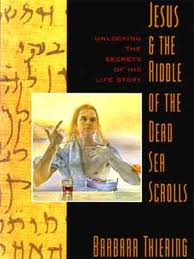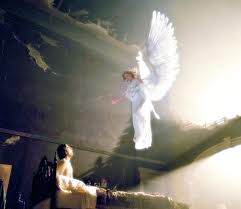|
"Gospel Pesher", What it Reveals about the Nativity of Jesus Christ (How it corrects quite a few seemingly impossible to solve problems!) |
|
|||
The name or description "Gospel Pesher"was not coined or invented by the University of Sydney (Australia) religious professor and Dead Sea Scroll researcher Dr. Barbara Thiering PhD, although the term was so unfamiliar to the general reading public that one would think this was the case. Before 1992 very few people, most of them other Dead Sea Scroll researchers, had ever heard about "Peshers" of any type, and Thiering was perhaps the first to connect this "Pesher" idea with the Gospels preserved in the New Testament Bible. In her 1992 book "Jesus and the Riddle of the Dead Sea Scrolls"(pictured above) Thiering describes the original "Peshers" found among the Dead Sea Scrolls in the late 1940s and 1950s this way on page 20 and onwards. "In a certain group of scrolls the Hebrew word "pesher" (plural "pesherim" is to be found, introducing a procedure that gives us a vital clue (to understanding events and parables that are puzzling to us in the Gospels as well as); the possibility of a new approach to works (these "peshers") that were regarded in the first century as sacred scripture." "The system works like this. The scroll writer takes an Old Testament book such as the minor prophet Habbakkuk, which deals with events in 600 BC, when the armies of the Babylonians were marching towards Judaea, inspiring fear and terror. He goes through it verse by verse, and after quoting each passage adds "its pesher is ....", then explains that it is really about events in his own time (600 years later). The Babylonians stand for the "Kittim", by which he means the Romans." "Some Romans were currently marching across the land, inspiring fear and terror. Other verses, he says, refer to the Teacher of Righteousness and his troubles with the Wicked Priest/Man of a Lie." (What makes Thiering's research unpopular with Christian theologians and other Dead Sea Scroll researchers is that she does not shrink from identifying John the Baptist as the "Teacher of Righteousness" because of his strict interpretations of Essene teachings in regards to marriage which cost the Baptist his head due to the jealosy and anger of Herodius, and Jesus Christ as the "Wicked Priest/Man of a Lie".) (The circumstances of Jesus' birth, with the uncertainty of who his father really was is very much a part of this "Man of a Lie" identification of Jesus by those who opposed his more liberal interpretation of Essene laws, and his associations with Zealots and other "Sinners" which eventually led to Jesus' crucifixion.) Thiering next on page 20 gives an example from the Habbakkuk Pesher, one of the Dead Sea Scrolls. "They are fearsome and terrible; their justice and grandeur proceed from themselves (Hab 1:7) "The pesher concerns the Kittim (Romans) who inspire all the nations with fear [and dread]. All their evil plotting is done with intention and they deal with all the nations in cunning and guile." "Woe to him who causes his neighbors to drink, who pours out his venom to make them drunk that he may gaze on their feasts! (Hab 2:15) "Its pesher concerns the Wicked Priest who pursued the Teacher of Righteousness to the house of his exile that he might confuse him with his venomous fury." "And at the time appointed for rest, for the Day of Atonement, he appeared before them to confuse them, and to cause them to stumble on the Day of Fasting, their sabbath of repose." (Later in her book, Thiering will show that several passages in the Christian Gospels in the New Testament describe, in a rather hidden fashion, how Jesus Christ did indeed do exactly what is described in this pesher. He did something quite unexpected on one of the Days of Atonement in the Gospel period of 29 to 33 AD. Not only unexpected but against Essene rules! All the facts of this affront to the Essenes are there to be seen, once the passages involved are properly interpreted using the techniques revealed by Thiering in her book. These and similar actions by Jesus during the 3 1/2 years involved earned for him, to a great number of Essenes, the title "Wicked Priest and Man of a Lie". That Jsus was unpopular with the Scribes and Pharisees in all of the Gospels is not exactly a SECRET, and is obvious to anyone who reads the Bible! So Thiering's theory is not as HERETICAL as it seems to us Christians!) Page 21 "The word "pesher" is used in the Old Testament to mean "interpretation of dreams". (Gen. 40:5 in the form pitron, 40:8 poter.) Genesis 40:5 "And they dreamed a dream both of them, each man his dream in one night, each man according to the (PESHER - pitron) interpretation of his dream, the butler and the baker of the king of Egypt, which were bound in the prison." Genesis 40:8 "And they said unto him, We have dreamed a dream, and there is no interpreter of it. And Joseph said unto them, do not (PESHERIM -poter) belong to God? tell me them, I pray you." Daniel 2:36 (Aramaic) "This is the dream; and we will tell the PESHER, the interpretation thereof before the king." Ecclesiastes 8:1 "Who is the wise man? and who knoweth the PESHER, the interpretation of a thing? a man's wisdom maketh his face to shine, and the boldness of his face shall be changed." Page 21 "A specially gifted person, a Joseph or a Daniel, could discover the hidden meaning of a dream, that was not apparent to others. The meaning had been put into the dream by God; the interpreter only had to see it, drawing on his special knowledge." "In simpler terms, the pesher is like a solution to a puzzle. A rough analogy might be the solution to a cryptic crossword. The clues do not look as if they make sense, but anyone who knows the technique and has the necessary knowledge can solve the puzzle." "Some aspects of the technique rely on giving words special meanings. For example, where the scripture says "the righteous", or "the wicked" appearing to mean all righteous or wicked men and making ethical statements, the pesherist turns the universals into particulars, and finds statements about historical events involving the Teacher of Righteousness (John the Baptist in 29-30 AD) and the Wicked Priest (Jesus and his partners Simon Magus and Judas Iscariot by 30 AD). "Thus he implies two levels of scripture: the surface containing general religious matter, suitable for ordinary readers, and beneath it specific historical matter, suitable only for those with special knowledge, knowledge of the events which "fitted" the text handled in this way. The surface remains valid; is not negated by the other meaning, and it meets people's general religious needs. But it does set up a "mystery", capable of solution by skilled experts."
Special Meanings 1,2 and 3 1) The "Angels" in the Gospel Nativity Stories, are not really spooky angels with wings, but are specific Essenes acting as religious "messengers" from God, and are real persons whose human identity is known by the other Essenes who are recieving these messages. EXAMPLE: The Angel Gabriel was a Essene whose real identity as a human being was Simeon, who brought the messages to both Zacharias in Luke 1:8-20 and Mary in Luke 1:26-38. 2) The "Holy Spirit" also could have a human form and could mean that Joseph, as the "Holy Spirit" could make Mary pregnant in an ordinary biological manner, by having sexual intercourse with her. 3) Anyone could be said to have "given up the spirit" or "given up the ghost "(as in John 19:30) by merely becoming unconscious and appearing to be dead --"When Jesus therefore had received the vinegar, he said, It is finished: and bowed his head, and gave up the ghost." |
|||
|
Nazareth was a part of Bethlehem and indeed even Qumran with its Monastery was to the Essenes, in the "Bethlehem" area! |



